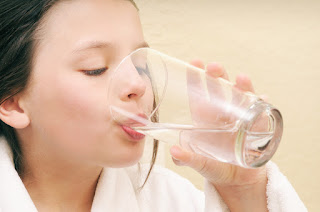One of the big changes to Canada's new Food Guide is the clear message about drinking water: "Make water your drink of choice".
Really? Don't we know that already?
Indeed we do. But here's the thing: our consumption of sugary drinks is through the roof and this is especially the case with children and teens. In fact, thanks to unrestricted food advertising to impressionable youth, sugary drinks are the number one source of added sugar in their diet.
Sugar is in fruit, vegetables and milk. These foods are also rich in nutrients. 'Added sugar' refers to the sugar that is added during food preparation and food processing. The issue with this added sugar is that it's in a ton of food products so it's easy to consume a lot of it. And too much added sugar leads to health problems, a big one being tooth decay. Here in Perth County added sugar in food and drinks is one of the reasons that about 44% of students in grade two have some form of tooth decay.
Since sugary drinks are the top source of added sugar, cutting back on them and drinking water instead can go a long way to curbing the health concerns associated with too much sugar. If you're a numbers person, you'll be interested to know that the World Health Organization recommends that we keep our added sugar intake from all food and drinks to 10 tsps/day (less is even better). One regular size pop (355 ml) has 10 tsp of sugar.
You might have guessed that pop is the number one choice of sugary drinks for children and teens. Other popular sugar laden drinks are fruit drinks, iced tea, flavoured milk, specialty coffees and teas and energy drinks. Even drinks that you'd think might be a better choice have lots of added sugars. A sports drink, for example, has 10 tsps of sugar and vitamin water has 8 tsps (and no, the vitamins in the water don't balance out the amount of added sugar!)
So, what's a parent to do? Sugary drinks are hard to avoid when you're out and about so a first step could be to reduce the amount of sugary drinks available at home.
Other ideas are:
- offer water with meals and snacks
- send water bottles with kids to school and sports
- make water more appealing by flavouring it with fruits and herbs
- keep a jug of water in the fridge
- work with your child's school to have water offered at events like school wide celebrations and track and field days
- advocate for easy access to water and fewer sugary drinks in places like rec centres, arenas and swimming pools
- show your support to pass legislation to stop marketing to kids at https://stopmarketingtokids.ca/

If you've got little ones at home, get them drinking water at an early age. Your baby can practice drinking water from an open cup when they start solid foods, around 6 months. They'll need your help at first but, with practice, they'll be a pro by 12 -15 months. If you use a sippy cup with little ones, use it only for milk at meals and water at other times. Avoid juice and other sugary drinks like chocolate milk, fruit drinks and punches. These can make your child feel too full to eat at meal and snack times. Plus, drinking these beverages from a sippy cup all day long constantly exposes the teeth to sugar and increases the risk of cavities.
For more ways to make water your drink of choice, check out this section of the food guide:
https://bit.ly/2Ywjr7a



Comments
Post a Comment